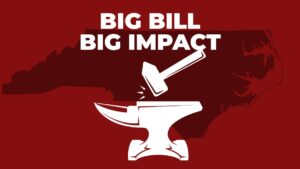A new study finds communities of color face the greatest increase in emergency room visits for flood-borne illnesses, showing the growing health risks and disproportionate burdens of climate change.
This story originally published at Inside Climate News.
North Carolina emergency rooms reported hundreds of visits for gastrointestinal illnesses like diarrhea, vomiting, and abdominal pain in the weeks during and after Hurricanes Florence, in 2018, and Matthew, in 2016. A new study released last month in the journal Science of the Total Environment found an 11 percent increase in ER visits during both storms, with the greatest surge among older, Black, and Native American patients.
The study is one of the first to look at emergency room visits for gastrointestinal concerns after hurricanes and examine how visitation rates vary between different demographic groups. It highlights the potential health effects of climate change as storms like Matthew and Florence become more common, as well as the ways in which those impacts aren’t shared equally.
“The issues we saw in terms of difference by race and ethnicity were concerning,” Arbor Quist, lead author of the study and a postdoc at the University of Southern California, said. “We saw a larger increase amongst Black and American Indian patients, populations that have historically been pushed to less desirable, flood-prone land.”
Heavy rain and flooding mobilize pathogens that can contaminate drinking water or make people exposed to floodwaters sick. The risk is highest for those with compromised immune systems or inadequate access to healthcare.
Eastern North Carolina is one of the soggiest parts of the state, and also among the poorest and most racially diverse. Residents there have higher-than-average rates of chronic ailments like asthma, diabetes and cardiovascular disease.
The region is also home to the kinds of industrial facilities that the researchers identified as potential sources of contamination, including coal ash ponds and concentrated animal feeding operations (CAFOs). North Carolina is the second leading pork-producing state in the country, and its hogs create more fecal waste each year than the state’s human population. During Hurricane Florence, the state estimates that at least 50 hog waste lagoons overflowed, contaminating water with fecal bacteria like E. coli and salmonella.
“Black residents and American Indian residents likely live in closer proximity to some of these sources of bacteria,” said Crystal Upperman, the vice president of social performance and resilience at the consulting firm AECOM. “This is an additional piece of evidence to showcase the adverse impact that people of color have when it comes to disasters.”
The study team used a public health surveillance system called NC DETECT, which tracks emergency room visits across North Carolina. Overlaying DETECT records of ER visits for gastrointestinal complications with flood extent maps, the researchers compared the visitation rates in zip codes flooded in the weeks after each storm to the rates anticipated had the storms not occurred.
“It’s a fantastic study,” said Julia Gohlke, an associate professor of environmental health at Virginia Tech. “Compared to other studies that just use case reports after flooding events, this is really a step in the right direction.”
A Wider Range of Diseases and Regions
But these findings aren’t unique to North Carolina, and disasters can create and exacerbate a slew of mental and physical health issues.
For example, a recent investigation illuminated the growing risk of infection from Vibrio, a group of pathogens that includes flesh-eating bacteria, as warming water and intensifying storm surges help the bacteria flourish and move inland. In North Carolina, the state health department reported 14 Vibrio infections in the four months after Hurricane Florence, triple the number during the same period in the previous year.
Gohlke has also been involved with similar work in Texas, using so-called syndromic surveillance systems like DETECT that collect data such as ER visits or Covid-19 cases to help officials monitor public health in real-time. Those studies found significant increases in ER visits after Tropical Storm Imelda and Hurricane Harvey for various conditions including intestinal issues, asthma and pregnancy complications.
“It really shows the power of using syndromic surveillance data that’s being collected by the state to look at health outcomes associated with flooding,” said Gohlke. “When combined with environmental data like flood inundation or precipitation, you can pinpoint areas that are probably going to be in need.”
Even with the best data, though, linking acute medical issues to a particular disaster remains challenging. Quist said that they can merely offer “hypothesized pathways” for how flooding-induced water contamination leads to GI distress. The DETECT database doesn’t specify the cause or severity of an emergency room visit.
“It’s difficult to draw firm conclusions,” Quist said. “Where were they exposed? Did they come into contact with floodwater? Did they drink contaminated water? We just don’t know.”
Previous studies have shown that few people with diarrheal illnesses seek out medical care, and even fewer go to emergency rooms. Quist believes the DETECT database is undoubtedly missing reports of post-hurricane illnesses, but she says that’s a reason to believe their findings are, if anything, an underestimate of the true health risk. This is particularly true in eastern North Carolina, where many residents are uninsured.
Another limitation of the research is that people move, said Rachel Nobles, a professor of marine science at the University of North Carolina. The DETECT database only includes North Carolina emergency departments and maps cases based on the patient’s billing address. If someone is riding out the storm away from home and gets sick, they’ll be counted in the zip code where they live, not where they were exposed. If an evacuee is treated outside of North Carolina, they’re not counted at all.
Once a hurricane hits, it’s also difficult to assess whether an illness was contracted from drinking water contamination, contact with dirty floodwater, or even from food spoilage due to a power outage.
Despite the shortcomings of available public health data, though, Nobles said the study is a “great first effort,” and the evidence to date suggests that flooding is indeed causing acute illnesses, giving those affected by storms and deluges yet another thing to worry about.
Health departments need to invest in education to ensure residents understand the risks of water contamination, particularly in communities that rely on well water, Quist said. Private wells are poorly regulated and rarely tested for the kinds of pathogens that make people sick. That’s a problem in a state where almost a third of the residents rely on household wells, she said.
Upperman also stressed the need to address how governments regulate facilities like hog CAFOs with waste lagoons that can fail during floods. She said the environmental justice movement, which began in North Carolina, has always been about the inequitable siting and impact of hazardous facilities.
North Carolinians, though, should think beyond the impact of hurricanes and consider water contamination an ongoing and increasing challenge, particularly as climate change stresses water treatment and waste management systems with intensifying storms, Nobles said.
“As much as this paper is very valuable for us to start to think about public health and preparedness for hurricanes, we have to think about the exposure of people during what we refer to as ‘normal’ conditions as well,” she said. “We have to think about the deterioration of our water quality generally.”





